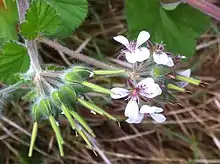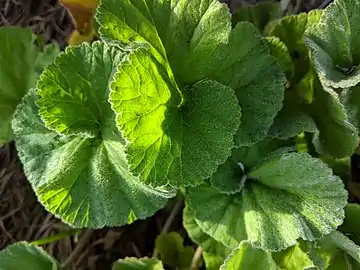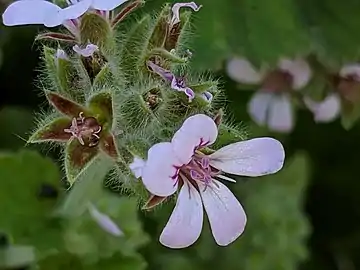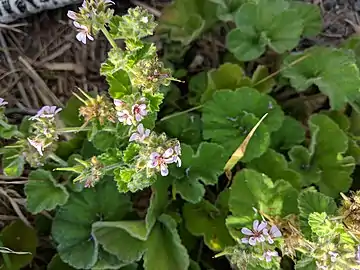| Pelargonium australe | |
|---|---|
_flower.JPG.webp) | |
| Flowers: Cambridge University Botanic Garden | |
 | |
| Flowers & fruit: Palm Beach, New South Wales | |
| Scientific classification | |
| Kingdom: | Plantae |
| Clade: | Tracheophytes |
| Clade: | Angiosperms |
| Clade: | Eudicots |
| Clade: | Rosids |
| Order: | Geraniales |
| Family: | Geraniaceae |
| Genus: | Pelargonium |
| Species: | P. australe |
| Binomial name | |
| Pelargonium australe | |
 | |
| Occurrence data from AVH | |
| Synonyms[3] | |
|
Geraniospermum australe (Willd.) Kuntze | |
Pelargonium australe is a perennial herb that is endemic to Australia, and found in all states except the Northern Territory.[4] Common names include native storksbill, wild geranium and austral storksbill.[4] The species grows to 50 cm high and has leaves with 5 to 7 lobes.[5] Umbels of 4 to 12 flowers appear between October and March in the species' native range. These are pink with darker markings.[5]
The species was first formally described in 1800 by German botanist Carl Ludwig Willdenow.[1]
It occurs on sand dunes, coastal cliffs and rocky outcrops.[5]
In cultivation, the species prefers a sunny or lightly shaded position and is adaptable to a wide range of soil types. It is readily propagated by cuttings.[6]
- P. australe: showing the hairy leaves, stems, bracts and other hairy parts



References
- 1 2 "Pelargonium australe". Australian Plant Name Index (APNI), IBIS database. Centre for Plant Biodiversity Research, Australian Government, Canberra. Retrieved 12 January 2014.
- ↑ Willdenow, C.L. (1800) Species Plantarum Edn. 4, 3(1): 675.
- ↑ Govaerts, R. et al. (2019) Plants of the world online: Pelargonium australe. Board of Trustees of the Royal Botanic Gardens, Kew. 15 January 2019.
- 1 2 VicFlora Flora of Victoria: Pelargonium australe. Retrieved 16 January 2019.
- 1 2 3 "Pelargonium australe". PlantNET - New South Wales Flora Online. Royal Botanic Gardens & Domain Trust, Sydney Australia. Retrieved 12 January 2014.
- ↑ "Pelargonium australe". Australian Native Plants Society (Australia). Archived from the original on 12 January 2014. Retrieved 12 January 2014.
External links
- Pelargonium australe Occurrence data from the Australasian Virtual Herbarium.
 Media related to Pelargonium australe at Wikimedia Commons
Media related to Pelargonium australe at Wikimedia Commons